Art Home | ARTH
Home | ARTH 200 Assignments
Sofonisba Anguissola
(c. 1532-1625)
In his Libro de Sogni published in 1564, Lomazzo presents this following imagined conversation between Leonardo da Vinci, representative of modern painting, and Phidias, the artist from Antiquity:
| I bring to your attention the miracles of a Cremonese woman called Sofonisba,
who has astonished every prince and wise man in all of Europe by means
of her paintings, which are all portraits, so like life they seem to conform
to nature itself. Many valiant [professionals] have judged her to have
a brush taken from the hand of the divine Titian himself; and now she is
deeply appreciated by Philip King of Spain and his wife who lavish the
greatest honors on the artist. |
While the vast majority of the known women artists from fifteenth
and sixteenth centuries were the daughters of established masters, and they
learned to paint within the context of the household economy of the late Medieval
and early Renaissance workshop, a significant exception to this rule is Sofonisba
Anguissola , born in Cremona, Italy, about 1532. She was the first of seven
children of Amilcare Anguissola, a member of the Genoese minor nobility. When
Sofonisba was fourteen she was sent by her father along with her sister Elena
to study art with Bernardino Campi, a respected religious painter and portraitist
in Cremona. Amilcare's intention was not to have his daughters trained to become
practicing artists in the trade. Sofonisba never sold a single one of her paintings.
Instead Amilcare saw learning to paint was part of the new Humanist education
for a woman of high social standing. Baldesar Castiglione in his Book of the Courtier, published in 1528, maps out the education of the lady at court:
| I want this [court lady] to be competent in letters, music, and painting,
to know how to dance and be merry, all performed with ...discreta modestia ...
being most graceful in conversing, laughing, playing games, creating mottoes,
and in everything she undertakes. |
Sofonisba's earliest paintings were self-portraits that testify to her discreta
modestia.  Sofonisba constructs herself as a woman of virtue. She identifies herself in a number of her paintings as "virgo." Female virtue was founded in chastity. Female virtue was also understood to include obedience, modesty, and silence. Her demeanor and simple dress, usually a near black jacket with a white lace collar, conform to these aspects of virtue. The self-portraits also attest to her competency in "letters, music, and painting." In
one self-portrait Sofonisba represents herself holding on to a small book
which bears the following inscription: "Sophonisba Angusola virgo seipsam
fecit 1554" [Sophonisba Anguissola, a virgin, made this herself in 1554]
." The small size of the book suggests a devotional book or a book of love
sonnets like those of Petrarch. Either would have been appropriate reading
material for a woman of her station.
Sofonisba constructs herself as a woman of virtue. She identifies herself in a number of her paintings as "virgo." Female virtue was founded in chastity. Female virtue was also understood to include obedience, modesty, and silence. Her demeanor and simple dress, usually a near black jacket with a white lace collar, conform to these aspects of virtue. The self-portraits also attest to her competency in "letters, music, and painting." In
one self-portrait Sofonisba represents herself holding on to a small book
which bears the following inscription: "Sophonisba Angusola virgo seipsam
fecit 1554" [Sophonisba Anguissola, a virgin, made this herself in 1554]
." The small size of the book suggests a devotional book or a book of love
sonnets like those of Petrarch. Either would have been appropriate reading
material for a woman of her station.  Her
musical training is attested to by the portrait of her playing the clavichord or virginal. Her chastity and obedience is attested to by the appearance of the governess on the left side of the composition.
Her
musical training is attested to by the portrait of her playing the clavichord or virginal. Her chastity and obedience is attested to by the appearance of the governess on the left side of the composition. 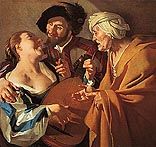 This image presents a stark contrast to the images of the procuress by artists like Dirck van Baburen as exemplified by a painting in Boston.
This image presents a stark contrast to the images of the procuress by artists like Dirck van Baburen as exemplified by a painting in Boston.
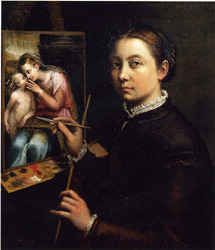
Sofonisba depicts herself painting an image of the Madonna
and Child. Besides attesting to her skills as an accomplished painter, this
painting also suggests her piety. It is significant that the religious paintings
of hers that have come down to us are not narrative representations but
rather devotional images. She did a number of paintings of the Madonna and
Child as well as images of the Pieta. These two of the most popular devotional subjects in Renaissance art focus
on the Joys and Sorrows of the Virgin Mary. Sofonisba who regularly identified
herself as a virgin in her signatures would have clearly identified herself
with the Virgin Mary. The image of the suckling Christ Child had since the
late Middle Ages been understood as attesting to the Virgin's Humility.
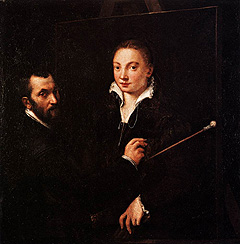
In the late 1550s, Sofonisba painted an intriguing self-portrait of her teacher Bernardino Campi painting her. The image calls to mind the subject-object relationship evident in Renaissance art as most famously illustrated by  Albrecht Dürer's illustration of a draftsman drawing a nude. This work, that has been much discussed in recent criticism, identifies the male artist as the active subject and the female model as the passive object. As defined in Barbara Freedman's discussion of the image, "we [the observer of the image] usually identify with the male as the appropriate bearer of the look, the female as the proper object of that look; we identify with reason against sexuality, activity over passivity, and seeing instead of showing." Sofonisba complicates this relationship by having Campi look out of the painting at us. In this context we become Sofonisba herself, the active maker of this painting. Sofonisba thus plays both the role of the subject and object, the viewer and the viewed, in this painting. The heads and hands of Campi and Sofonisba stand out starkly against the dark background and clothing of the two figures. This calls attention to the conception of painting as being the interconnection between the intellectual and manual. The hand of Campi actively painting is set directly above the relaxed, inactive hand of Sofonisba. Just as Campi constructs Sofonisba's image in the painting, Campi also trained Sofonisba's artistic hand. Considering that Sofonisba employed a mirror in creating her image, the prominent hand in the painting would be her right hand. Mary Garrard in her discussion of the painting [reprinted in Reclaiming Female Agency, p.28] calls attention to a 1554 letter from Francesco Salviati to Bernardino Campi where he characterizes Sofonisba as "the beautiful Cremonese painter, your creation" and that her work is a product of Bernardino's "beautiful intellect." Sofonisba painted this work after she had left Bernardino Campi's workshop. It thus can be seen as an homage by Sofonisba to her old teacher in the role he played in fashioning her as an artist.
Albrecht Dürer's illustration of a draftsman drawing a nude. This work, that has been much discussed in recent criticism, identifies the male artist as the active subject and the female model as the passive object. As defined in Barbara Freedman's discussion of the image, "we [the observer of the image] usually identify with the male as the appropriate bearer of the look, the female as the proper object of that look; we identify with reason against sexuality, activity over passivity, and seeing instead of showing." Sofonisba complicates this relationship by having Campi look out of the painting at us. In this context we become Sofonisba herself, the active maker of this painting. Sofonisba thus plays both the role of the subject and object, the viewer and the viewed, in this painting. The heads and hands of Campi and Sofonisba stand out starkly against the dark background and clothing of the two figures. This calls attention to the conception of painting as being the interconnection between the intellectual and manual. The hand of Campi actively painting is set directly above the relaxed, inactive hand of Sofonisba. Just as Campi constructs Sofonisba's image in the painting, Campi also trained Sofonisba's artistic hand. Considering that Sofonisba employed a mirror in creating her image, the prominent hand in the painting would be her right hand. Mary Garrard in her discussion of the painting [reprinted in Reclaiming Female Agency, p.28] calls attention to a 1554 letter from Francesco Salviati to Bernardino Campi where he characterizes Sofonisba as "the beautiful Cremonese painter, your creation" and that her work is a product of Bernardino's "beautiful intellect." Sofonisba painted this work after she had left Bernardino Campi's workshop. It thus can be seen as an homage by Sofonisba to her old teacher in the role he played in fashioning her as an artist.
A concern for many of her male counterparts was to attempt to elevate their
social position. As noted in our discussion of Baccio Bandinelli's Self-Portrait,
the aspiration to attain noble status was an important issue. The title of
Court Artist was a reward for artists of merit. In contrast Sofonisba was born
into her social status as a member of the nobility. Like
other young women of her social station becoming a member of a royal or ducal
household was a goal. For young noble women to serve as a Lady in Waiting attending
to the person of a queen or princess was a real privilege. In 1558 Sofonisba went to Milan where the Duke of Alba introduced her to the court of Spain. She joined fourteen Spanish and five French women as Ladies in Waiting in the household of Philip II's new bride and his third wife, Isabel de Valois. Vasari records this in the following account included in his 1568 edition of his Lives:
| She executed by herself very rare and very beautiful paintings; wherefore
she well deserved that King Philip of Spain, having heard of her abilities
and merits from the Duke of Alba, should have sent for her and had her
conducted honorably to Spain, where he keeps her with a rich allowance
in the Queen's retinue, to the admiration of the whole court which admires
Sofonisba's excellence as something miraculous. |
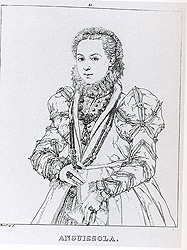 It
has
It
has 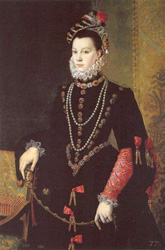 been
claimed that "After Michelangelo and Titian,
Sofonisba Anguissola may have been the best-known artist --certainly the best-known
court artist-- in the Cinquecento [Joanna Woods-Marsden, Renaissance Self-Portraiture,
p.191]." While not diminishing the quality of her work, her fame and notoreity
can be understood to be based on her position as a noble woman trained in art
serving in Europe's most prestigious court at the time. One of her roles at
court was to tutor the Queen in drawing and painting. An Italian visitor to
the court in 1561 reported that "she [the Queen] has begun to paint, and
Sofonisba of Cremona, who is her teacher, says...that she draws in charcoal
in such a way that the person portrayed is immediately recognisable." An
engraving of a now lost painting documents her status as a member of court.
She wears the chains probably given her by Philip II. Her sumptuous pearl embroidered
dress stands in contrast to the simpler dress of her earlier self-portraits.
This dress is possibly one given to her by the queen. Going back to at least
the thirteenth century, clothing was one of the basic forms of remuneration
for a court artist. In 1257 the English court accounts refer to a Petro de
Ispannia who is identified as "pictor regis" (King's painter) who received
"unam robam sibi convenientem de dono regis." The court artist wearing a "robe
befitting him" defined the artist's membership in the court. The
three-quarters format also contrasts with the half-length format of her earlier
portraits. This three-quarters format is that characteristic of court portraits
like that employed by Sofonisba herself in her portrait of the Queen of Spain,
Isabel de Valois. Her now lost self-portrait thus constructs Sofonisba's status
as a member of the court of Spain.
been
claimed that "After Michelangelo and Titian,
Sofonisba Anguissola may have been the best-known artist --certainly the best-known
court artist-- in the Cinquecento [Joanna Woods-Marsden, Renaissance Self-Portraiture,
p.191]." While not diminishing the quality of her work, her fame and notoreity
can be understood to be based on her position as a noble woman trained in art
serving in Europe's most prestigious court at the time. One of her roles at
court was to tutor the Queen in drawing and painting. An Italian visitor to
the court in 1561 reported that "she [the Queen] has begun to paint, and
Sofonisba of Cremona, who is her teacher, says...that she draws in charcoal
in such a way that the person portrayed is immediately recognisable." An
engraving of a now lost painting documents her status as a member of court.
She wears the chains probably given her by Philip II. Her sumptuous pearl embroidered
dress stands in contrast to the simpler dress of her earlier self-portraits.
This dress is possibly one given to her by the queen. Going back to at least
the thirteenth century, clothing was one of the basic forms of remuneration
for a court artist. In 1257 the English court accounts refer to a Petro de
Ispannia who is identified as "pictor regis" (King's painter) who received
"unam robam sibi convenientem de dono regis." The court artist wearing a "robe
befitting him" defined the artist's membership in the court. The
three-quarters format also contrasts with the half-length format of her earlier
portraits. This three-quarters format is that characteristic of court portraits
like that employed by Sofonisba herself in her portrait of the Queen of Spain,
Isabel de Valois. Her now lost self-portrait thus constructs Sofonisba's status
as a member of the court of Spain.
 The
miniature self-portrait on vellum now in Boston was probably made as a gift
for a princely patron in Italy or Spain. It perhaps served as an introduction
to a prospective patron. The monogram of her father's name on the shield that
she holds attests to her family's noble ancestry which traced its lineage back
to Carthaginians. The inscription around the monogram attests to her virtue
by explicitly identifying her as a virgin.
The
miniature self-portrait on vellum now in Boston was probably made as a gift
for a princely patron in Italy or Spain. It perhaps served as an introduction
to a prospective patron. The monogram of her father's name on the shield that
she holds attests to her family's noble ancestry which traced its lineage back
to Carthaginians. The inscription around the monogram attests to her virtue
by explicitly identifying her as a virgin.
The inscription also states that
Sofonisba had made this image by her own hand from a mirror ( ipsius manu ex
[s]peculo depictam). This
self-portrait based on a mirror image as a gift for a prospective patron raises
an interesting parallel to one of the most remarkable self-portraits of the
sixteenth century, that made by Parmigianino in hopes of gaining the patronage
of Pope Clement VII. Vasari presents the following account of the creation of this self-portrait:
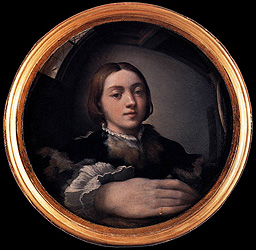
| Then came upon him the desire to see Rome, hearing men greatly praise the works of the masters there, especially of Raffaello and Michael Angelo, and he told his desire to his old uncles. They, seeing nothing in the desire that was not praiseworthy, agreed, but said that it would be well to take something with him which would gain him an introduction to artists. And the counsel seeming good to Francesco, he painted three pictures, two small and one very large. Besides these, inquiring one day into the subtleties of art, he began to draw himself as he appeared in a barber's convex glass. He had a ball of wood made at a turner's and divided in half, and on this he set himself to paint all that he saw in the glass, and because the mirror enlarged everything that was near and diminished what was distant, he painted the hand a little large. Francesco himself, being of very beautiful countenance and more like an angel than a man, his portrait on the ball seemed a thing divine, and the work altogether was a happy success, having all the lustre of the glass, with every reflection and the light and shade so true, that nothing more could be hoped for from the human intellect.
The picture being finished and packed, together with the portrait, he set out, accompanied by one of his uncles, for Rome; and as soon as the Chancellor of the Pope had seen the pictures, he introduced the youth and his uncle to Pope Clement, who seeing the works produced and Francesco so young, was astonished, and all his court with him. And his Holiness gave him the charge of painting the Pope's hall. |
This tour de force self-representation in a convex mirror constructs Parmigianino as a refined courtier with his beautiful, youthful face which Vasari thought "more like an angel than a man" and fine, fur clothing. The prominence of Parmigianino's hand in the foreground
of the painting parallels Sofonisba's verbal statement that the image was made
by her own hand. Both images demonstrate the respective artists' mastery of
illusionistic techniques as well as identifying as having the background and
manners appropriate to be a member of a court. 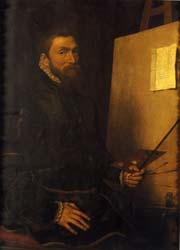 Similar
claims can be seen in Sofonisba's contemporary at the court of Spain. In his self-portrait
from 1558, Antonis Mor identifies himself in an inscription on the side of
the easel as "PHILIPPI HISP. REG. PICTOR(Painter of Philip the King of Spain)." A poem, written in Greek, tacked onto the empty canvas, equates the work of
Mor to that of Zeuxis and Apelles.
Similar
claims can be seen in Sofonisba's contemporary at the court of Spain. In his self-portrait
from 1558, Antonis Mor identifies himself in an inscription on the side of
the easel as "PHILIPPI HISP. REG. PICTOR(Painter of Philip the King of Spain)." A poem, written in Greek, tacked onto the empty canvas, equates the work of
Mor to that of Zeuxis and Apelles.  The
illusionistic representation of the piece of paper affixed to the canvas with
a gold needle was undoubtedly intended to be like the curtain painted by Parrhasius
that fooled Zeuxis in their famous competition for mastery of illusionistic
painting, and of course Apelles was the great ancient precedent of the court
artist. Like Sofonisba and Parmigianino, Mor bases the veracity of his self-portrait
on the use of a mirror: "He painted it with his own skilled hand. / He studied
himself in a metal, / In front of the mirror. /Oh what an excellent artist!
/ The counterfeit Mor which you now behold, /Mor...presently speak"
The
illusionistic representation of the piece of paper affixed to the canvas with
a gold needle was undoubtedly intended to be like the curtain painted by Parrhasius
that fooled Zeuxis in their famous competition for mastery of illusionistic
painting, and of course Apelles was the great ancient precedent of the court
artist. Like Sofonisba and Parmigianino, Mor bases the veracity of his self-portrait
on the use of a mirror: "He painted it with his own skilled hand. / He studied
himself in a metal, / In front of the mirror. /Oh what an excellent artist!
/ The counterfeit Mor which you now behold, /Mor...presently speak"

Sofonisba Anguissola, Bernardino Campi Painting Sofonisba Anguissola, c. 1550.
|

Sofonisba Anguissola, Self-Portrait, 1554. The book bears the
following inscription: "Sophonisba Angusola virgo seipsam fecit
1554" [Sophonisba Anguissola, a virgin, made this herself in 1554]
|

Sofonisba Anguissola, Self-Portrait Painting the Virgin, 1556.
|

Sofonisba Anguissola, Self-Portrait wiht Clavichord, 1561.
|

Sofonisba Anguissola, The Chess Game, 1555. [for the representation of chess see Patricia Simons, "(Check)Mating the Grand Masters: The Gendered, Sexualized Politics of Chess in Renaissance Italy, " Oxford Art Journal, 16 (1993), pp. 59-74 (download from JSTOR)]
|

Sofonisba Anguissola, Self-Portrait holding a medallion with the Letter's of her Father's Name, early 1550s. The complex monogram spells out AMILCARE. Around the frame of the monogram is the following inscription: "Sophonisba Angussola vir[go] ipsius manu ex [s]peculo depictam Cremonae" (Painted from a mirror by her own hand Sophonisba Anguissola, virgin from Cremona.)
|

Engraved copy of Sofonisba Anguissola, Self-Portrait, 1560s. This self-portrait apparently commemorates Philip II's gift of a gold chain. Her sumptuous pearl embroidered dress stands in contrast to the simpler dress of her earlier self-portraits. This dress is possibly one given to her by the queen. The three-quarters format also contrasts with the half-length format of her earlier portraits. This three-quarters format is that characteristic of court portraits like that employed by Sofonisba herself in her portrait of the Queen of Spain, Isabel de Valois. This now lost painting constructs Sofonisba's status as a member of the court of Spain.
|
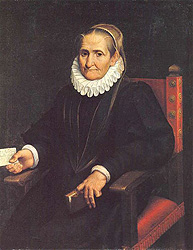
Sofonisba Anguissola, Self-Portrait, c. 1610.
|
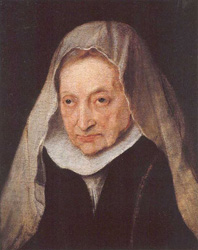
Sofonisba Anguissola, Self-Portrait, 1620s.
|
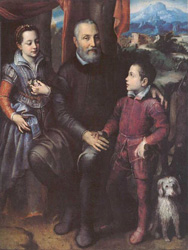
Sofonisba Anguissola, Amilcare Anguissola with his daughter Minerva and son Asdrubale.
|

Sofonisba Anguissola, Queen Isabel de Valois (third wife of King Philip II of Spain.
|
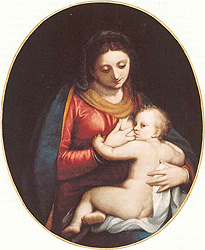
Sofonisba Anguissola, Virgin and Child.
|

Sofonisba Anguissola, Pieta.
|
 Sofonisba constructs herself as a woman of virtue. She identifies herself in a number of her paintings as "virgo." Female virtue was founded in chastity. Female virtue was also understood to include obedience, modesty, and silence. Her demeanor and simple dress, usually a near black jacket with a white lace collar, conform to these aspects of virtue. The self-portraits also attest to her competency in "letters, music, and painting." In
one self-portrait Sofonisba represents herself holding on to a small book
which bears the following inscription: "Sophonisba Angusola virgo seipsam
fecit 1554" [Sophonisba Anguissola, a virgin, made this herself in 1554]
." The small size of the book suggests a devotional book or a book of love
sonnets like those of Petrarch. Either would have been appropriate reading
material for a woman of her station.
Sofonisba constructs herself as a woman of virtue. She identifies herself in a number of her paintings as "virgo." Female virtue was founded in chastity. Female virtue was also understood to include obedience, modesty, and silence. Her demeanor and simple dress, usually a near black jacket with a white lace collar, conform to these aspects of virtue. The self-portraits also attest to her competency in "letters, music, and painting." In
one self-portrait Sofonisba represents herself holding on to a small book
which bears the following inscription: "Sophonisba Angusola virgo seipsam
fecit 1554" [Sophonisba Anguissola, a virgin, made this herself in 1554]
." The small size of the book suggests a devotional book or a book of love
sonnets like those of Petrarch. Either would have been appropriate reading
material for a woman of her station.  Her
musical training is attested to by the portrait of her playing the clavichord or virginal. Her chastity and obedience is attested to by the appearance of the governess on the left side of the composition.
Her
musical training is attested to by the portrait of her playing the clavichord or virginal. Her chastity and obedience is attested to by the appearance of the governess on the left side of the composition.  This image presents a stark contrast to the images of the procuress by artists like Dirck van Baburen as exemplified by a painting in Boston.
This image presents a stark contrast to the images of the procuress by artists like Dirck van Baburen as exemplified by a painting in Boston.













